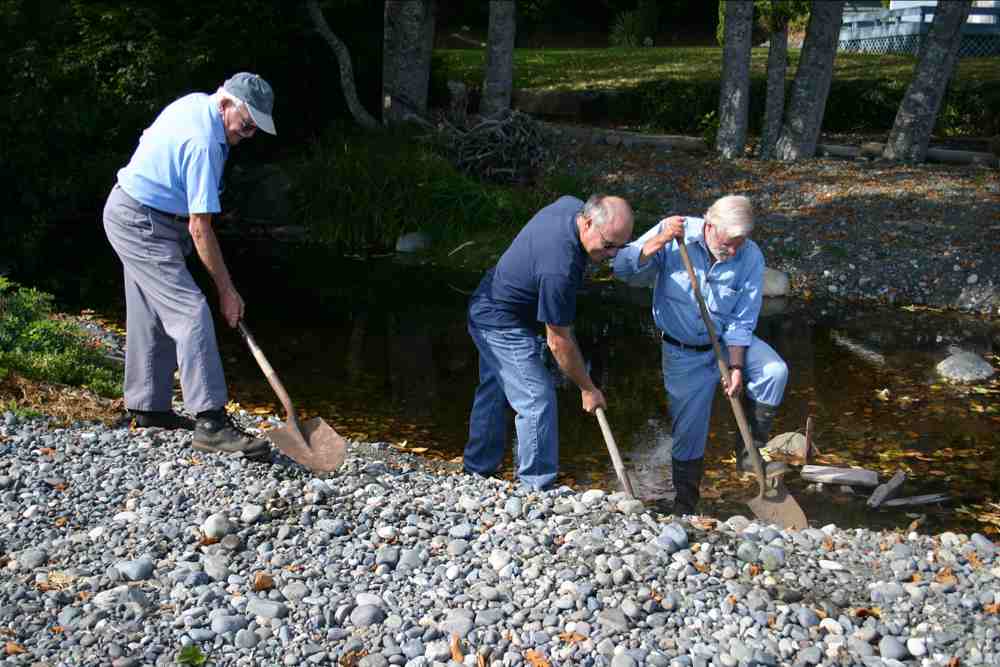 The restoration of Nile Creek from a river that was devoid of fish into a salmon and cutthroat trout-bearing stream rich in life prompted Fisheries and Oceans Canada (DFO) biologists to hail it as an example for the rest of British Columbia. The project was so successful that fish stocks were restored to capacity, with pink salmon smolt even surpassing what the creek produced in the 1950s…
The restoration of Nile Creek from a river that was devoid of fish into a salmon and cutthroat trout-bearing stream rich in life prompted Fisheries and Oceans Canada (DFO) biologists to hail it as an example for the rest of British Columbia. The project was so successful that fish stocks were restored to capacity, with pink salmon smolt even surpassing what the creek produced in the 1950s…
Now the the Nile Creek Enhancement Society is taking on five other streams near Bowser, the waterfront community on the east coast of Vancouver Island.
The challenge in each is as great or greater than Nile Creek, which was a project that took over 10 years to complete and cost $306,000, all of it money raised by the society.
The first issue with the new creeks is access, which is possible only in the winter during high tides. Tons of debris, gravel, rocks and sand have to be moved to unblock the entrances. Then walls of rock have to be built to keep the mouths of the creeks open. After that, the core work of restoring the creeks begins. Perhaps most importantly, the society’s president, Ken Kirkby insisted, the nearby ocean habitat must also be restored.
Returning the Salmon
“When I was 18 there were Coho here by the ton. There were also kelp beds and beds of eel grass.”
Kirkby says that sending fish out from the hatcheries to the open ocean without the protection of kelp beds is like sending a three-year-old child into the wilderness alone.
Salmon use the undersea kelp forests as sheltered places to wait until the conditions are right to swim upstream, says DFO biologist, Mel Sheng.
“Historically, we know that the kelp beds were major feeding areas and we know that they’re important for juvenile survival rates.”
 (photo, left – volunteers Rod Allan, Jack Gillen and Ken Kirkby dig up gravel and debris that blocks the entrance to Thames Creek)
(photo, left – volunteers Rod Allan, Jack Gillen and Ken Kirkby dig up gravel and debris that blocks the entrance to Thames Creek)
The society has set a goal of completing the work within five years. Kirkby says he hopes to finish sooner but for that he needs more volunteers and preferably people younger than the average age of the current volunteers, which is 60-plus. He adds that he hopes the recent agreement the society has made with Malaspina University-College to raise sea-run cutthroat trout in Nile Creek will be the beginning of attracting younger people to the cause.
Frank Dalziel, a fisheries technologist at Malaspina University-College says he expects that the Bowser area streams will indeed become an outdoor classroom for his students. He calls the work the volunteers have done “amazing.”
“I’m a recreational angler myself and I, and many others, have been the beneficiary of their hard work. They made it work against all odds.”
Against All Odds
In addition to the physical labour is the enormous job of raising funds. Kirkby says the annual grant from the government of about $5,000 is negligible and the challenges are enough to discourage anyone.
“And I find myself having to caution our membership frequently that even though at times it looks like we’re gardening in Armageddon, the only advice I can give is, "Keep gardening.’”
“Keep gardening,” he says because the cause is much larger than a handful of creeks on Vancouver Island.
“We’re after a model of what can be done so that we can then expand this throughout the Georgia Basin. If this were repeated according to the needs of each particular stream, my gut tells me that we could very well have a fishery that would become sustainable… We don’t know but I’m prepared to use the energies and money and the time of my life to find out.”
on Vancouver Island, Canada




















Hope sometimes comes one drop at a time
We spend our summers in the Oceanside area of Vancouver Island, not far from Bowser, and I was totally unaware of this group, and it’s important work. I admire Mr. Kirkby and all of his volunteers, both workers and fund raisers. Because of this article, I hope to contact them to help out in any way I can this summer. It’s the small efforts that will turn our world around ecologically and environmentally, and we can ALL make small efforts. Kudos and thanks to the group, and to this website for sharing the story.